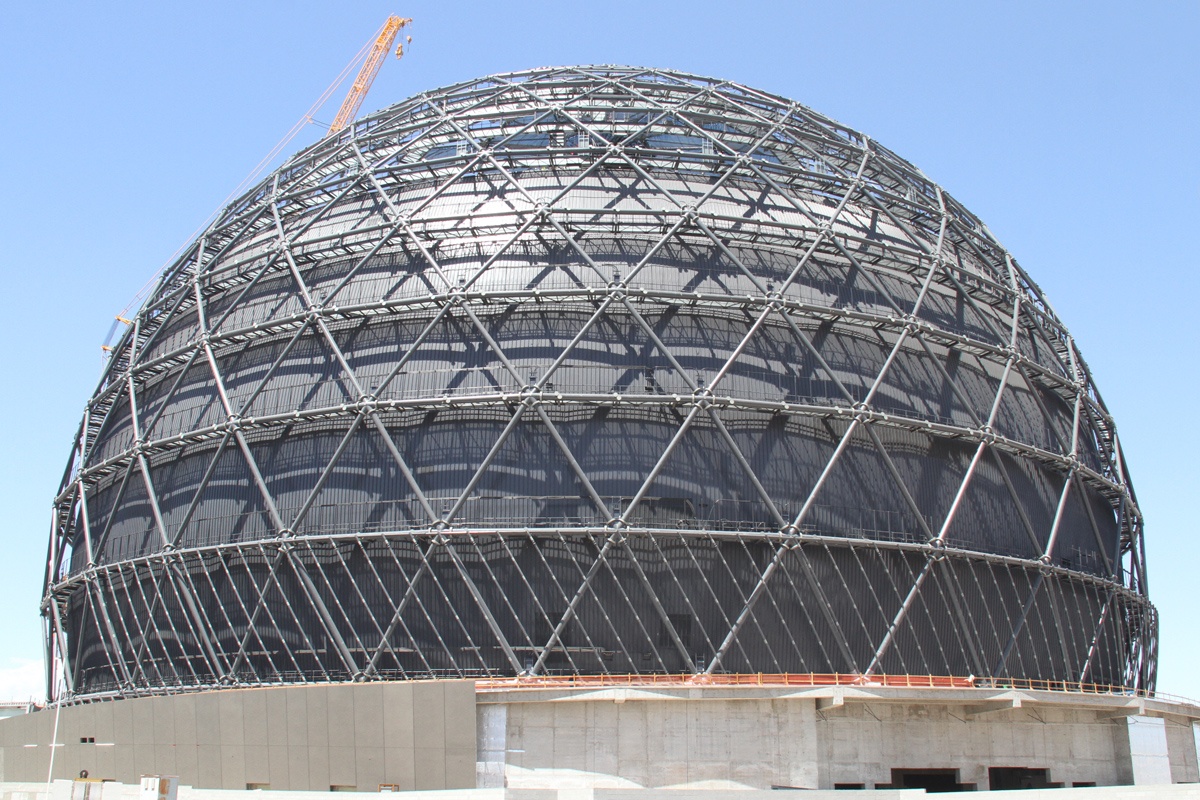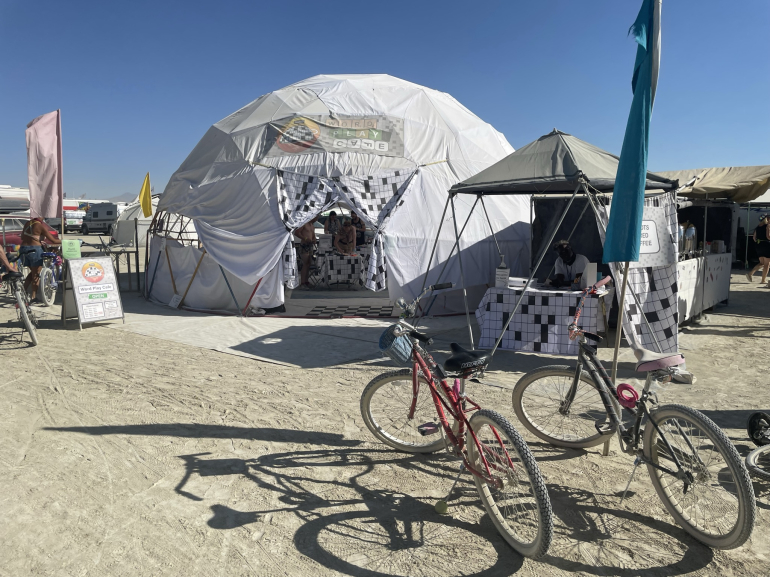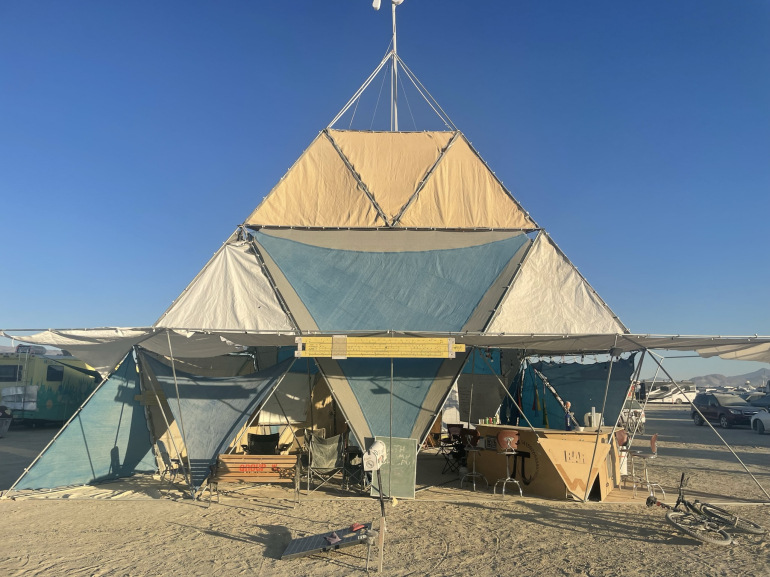
Image source: Wikipedia
However, it evidently is not. Parallel to the ground you see concentric rings. Domes like the Biosphere have some rings that are slightly jagged. Also, icosahedron-based domes have 20 points with 5 extending edges, the rest having 6. With the Vegas Sphere, every point has 6 extending edges, except on the top three rings.
After looking at many pictures, here is what I've discovered.
There are what I'll 9 full layers that are basically the same. The triangles are bigger closer to the equator. All triangles within these layers are close to being equilateral.
However, layers 10 and 11 are different. Every point has an edge that goes straight up. Every other point also has two more edges extending from it to the next layer. Starting at the top of layer 9 we start to see points with 5 extending edges, in fact half of them.
Above layer 11 things would get too crowded to keep going with the triangles so I believe they just have a circle. I have yet to see an image of the Sphere looking directly down and where you can see the dome structure edges.
I had to eyeball it to estimate how many edge pieces are on each layer. 28 is my best guess. It would be nice to get a definitive source. I got this by loading the image from the video liked below into Paint and dividing the pixels in the diameter to the one edge directly facing the viewer. It actually game to about 28.4. It must be an even number for reasons that will be explained later.
Here are some rough counts I get thus far of the whole thing, including the bottom ring:
Points = 336
Faces = 616
Edges = 616
Here are some images I used and for purposes of discussion:

Source: MSG Sphere Enters Next Phase of Construction at Casino.org
Be careful when using this image to count anything. There is a sphere inside a sphere. This, I believe, to be the inside sphere that is used as the projection screen.
I'm not able to upload images at the moment, so please you to this YouTube video and look at the 9 second point for the exterior structure.
Direct: https://youtu.be/ONsEhZPbkF0?si=LW_W8xB0G9iwQdyx&t=9
I'll stop here for now. About three hours of work went into this post and I've found passionate and time-consuming posts like this tend to engender very few, often zero, replies.
Again, this is just a starting point in my work. I'm thinking of building a scale model. Thank you for reading -- both of you.
Links:
Wikipedia
Geodesic Math, from The Sphere web site
The $1.8BILLION sphere that will change the Las Vegas Strip forever: World's largest concert sphere is set to be the Madison Square Garden of Nevada from the Daily Mail.
I'm going to use a word from advanced math, but triangulating a surface is fundamental to what's known as homotopy theory. It allows surfaces to be categorized by their topological properties.
For example:
https://en.wikipedia.org/wiki/Triangulation_(topology)
Sorry.
Quote: teliotMike, you're going intuitively very deep here.
I'm going to use a word from advanced math, but triangulating a surface is fundamental to what's known as homotopy theory. It allows surfaces to be categorized by their topological properties.
For example:
https://en.wikipedia.org/wiki/Triangulation_(topology)
Sorry.
link to original post
I don't know a lot about math but I have used triangulation for over 30 years to do 3D computer modeling.The weirdest project that I ever worked on was doing 3D reconstructions of bed sores.
IANASE (I am not a structural engineer.) I am waiting for EB to chime in and set me straight.
Quote: Mental
IANASE (I am not a structural engineer.) I am waiting for EB to chime in and set me straight.
Yes
Quote: MentalWhen you make the largest structure of any type, I would think that the structural loads constrain the design. In this case, the wind loads might be much higher than the dead weight loads. ...
link to original post
I'm not a structural engineer either, but in watching several videos on geodesic domes they often made the point that they are very strong and stable. That may explain why you see so many of them at Burning Man.
Absent gravity, the strongest pressure vessel (pound for pound) is a perfect sphere. For example, the Bathysphere. Geodesic domes approximate a sphere using flat elements. However, the loads on a spherical structure sitting on the ground are not radial and symmetrical like the loads on a bathysphere. The roof of the sphere is being pulled inward by gravity (the roof contains 10,000 tons of concrete). The equator is being pushed outwards counteracting the weight of the upper part of the sphere. A 170-ton steel compression ring was added to the design of the sphere to contain the outward bulging. If the sphere were floating in zero gravity, the ring would not be needed. The somewhat vertical spiral ribs are supporting the mass of the sphere against gravity.Quote: WizardQuote: MentalWhen you make the largest structure of any type, I would think that the structural loads constrain the design. In this case, the wind loads might be much higher than the dead weight loads. ...
link to original post
I'm not a structural engineer either, but in watching several videos on geodesic domes they often made the point that they are very strong and stable. That may explain why you see so many of them at Burning Man.
link to original post
Basically, I am saying that the geodesic form is not optimum when the loads on the structure are so asymmetrical.

Above is one of my favorite camps, the Word Play Cafe. Their main structure follows the typical geodesic dome model.

However, surprisingly, the Math Camp above has a tetrahedron structure. I'll have to ask them about the pros and cons between that and the dome my next visit.


